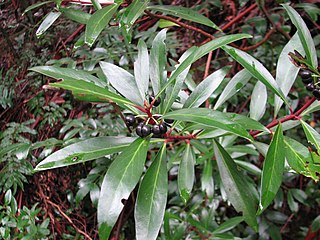
The flannel moths or crinkled flannel moths are a family of insects. They occur in North America and the New World tropics. The larvae are called puss caterpillars, and with their long hairs, resemble cotton balls. They have venomous spines that can cause a painful sting and inflammation lasting for several days. In some cases, the sting may cause headache, nausea, and shock-like symptoms. Perhaps the most notorious for stinging is the caterpillar of Megalopyge opercularis.

Tasmannia lanceolata, commonly known as Tasmanian pepperberry, mountain pepper (Aus), or Cornish pepper leaf (UK), is a shrub native to woodlands and cool temperate rainforest of south-eastern Australia. The shrub varies from 2 to 10 m high. The aromatic leaves are lanceolate to narrow-elliptic or oblanceolate, 4–12 cm long, and 0.7–2.0 cm wide, with a distinctly pale undersurface. Stems are quite red in colour. The small cream or white flowers appear in summer and are followed by black, globose, two-lobed berries 5–8 mm wide, which appear in autumn. There are separate male and female plants.

Persoonia lanceolata, commonly known as lance-leaf geebung, is a shrub native to New South Wales in eastern Australia. It reaches 3 m (9.8 ft) in height and has smooth grey bark and bright green foliage. Its small yellow flowers grow on racemes and appear in the austral summer and autumn, followed by green fleshy fruits which ripen the following spring. Within the genus Persoonia, P. lanceolata belongs to the lanceolata group of 58 closely related species. It interbreeds with several other species found in its range.
Megalopyge is a genus of moth in the family Megalopygidae.
Megalopyge lapena is a moth of the family Megalopygidae. It was described by Schaus in 1896. It is found in Mexico and southern Arizona.
Megalopyge brunneipennis is a moth of the family Megalopygidae. It was described by Schaus in 1905. It is found in Brazil.
Megalopyge hyalina is a moth of the Megalopygidae family. It was described by William Schaus in 1905. It is found in Brazil.
Megalopyge hina is a moth of the Megalopygidae family. It was described by Paul Dognin in 1911. It is found in Guyana.
Megalopyge trossula is a moth of the family Megalopygidae. It was described by Paul Dognin in 1891. It is found in Costa Rica.
Megalopyge affinis is a moth of the family Megalopygidae. It was described by Herbert Druce in 1887. It is found in Mexico.
Megalopyge albicollis is a moth of the family Megalopygidae. It was described by Francis Walker in 1855.
Megalopyge chrysocoma is a moth of the Megalopygidae family. It was described by Gottlieb August Wilhelm Herrich-Schäffer in 1856. It is found in Venezuela.
Megalopyge defoliata is a moth of the Megalopygidae family. It was described by Francis Walker in 1855. It is found in Mexico.
Megalopyge dyari is a moth of the family Megalopygidae. It was described by Hopp in 1935. It is found in Mexico.
Megalopyge krugii is a moth of the family Megalopygidae. It was described by Hermann Dewitz in 1897.
Megalopyge lampra is a moth of the family Megalopygidae. It was described by Harrison Gray Dyar Jr. in 1910.
Megalopyge lecca is a moth of the Megalopygidae family. It was described by Herbert Druce in 1890.
Megalopyge nuda is a moth of the Megalopygidae family. It was described by Caspar Stoll in 1789. It is found in Guyana and Paraguay.
Megalopyge undulata is a moth of the family Megalopygidae. It was described by Gottlieb August Wilhelm Herrich-Schäffer in 1858. It is found in Brazil, Paraguay and Argentina.

Megalopyge xanthopasa is a moth of the family Megalopygidae. It was described by Sepp in 1828. It is found in Surinam and French Guiana.





